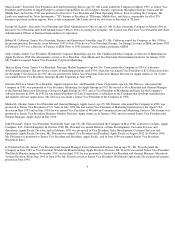Apple 1996 Annual Report Download - page 20
Download and view the complete annual report
Please find page 20 of the 1996 Apple annual report below. You can navigate through the pages in the report by either clicking on the pages listed below, or by using the keyword search tool below to find specific information within the annual report.Competition
The personal computer industry is highly competitive and is characterized by aggressive pricing practices, downward pressure on gross
margins, frequent introduction of new products, short product life cycles, continual improvement in product price/performance characteristics,
price sensitivity on the part of consumers, and a large number of competitors. During 1996, the Company's results of operations and financial
condition were, and in the future may continue to be, adversely affected by industrywide pricing pressures and downward pressures on gross
margins. The industry has also been characterized by rapid technological advances in software functionality and hardware performance and
features based on existing or emerging industry standards. Many of the Company's competitors have greater financial, marketing,
manufacturing, and technological resources; broader product lines; and larger installed customer bases than those of the Company.
The Company's future operating results and financial condition may be affected by overall demand for personal computers and general
customer preferences for one platform over another or one set of product features over another.
The Company is currently the primary maker of hardware that uses the Macintosh operating system ("Mac(registered trademark) OS"). The
Mac OS has a minority market share in the personal computer market, which is dominated by makers of computers that run the MS-DOS and
Microsoft Windows operating systems. The Company believes that the Mac OS, with its perceived advantages over MS-DOS and Windows,
has been a driving force behind sales of the Company's personal computer hardware for the past several years. Recent innovations in the
Windows platform, including those introduced by Windows 95, have added features to the Windows platform similar to those offered by the
Mac OS. The Company is currently taking and will continue to take steps to respond to the competitive pressures being placed on its personal
computer sales as a result of the recent innovations in the Windows platform. The Company's future operating results and financial condition
may be affected by its ability to maintain and increase the installed base for the Macintosh platform. The Company recently announced a new
strategy with respect to updating its operating system while redesigning its plan for a next- generation operating system. To extend the life of
its current operating system, the Company intends to issue periodic releases consisting of discrete operating system components. The Company
expects that this will enable it to introduce some new functionality for the current operating system sooner than it would be able to introduce a
completely new operating system. Concurrently, the Company will continue development of its next-generation operating system, focusing on
increased functionality at the possible expense of some backward compatibility. Diminished backward compatibility in its new operating
system could result in a loss of existing customers. Inability to introduce a next- generation operating system on a timely basis, or to gain
developer support and market accepatance for it, may have an adverse impact on the Company's operating results and financial condition.
As part of its efforts to increase the installed base for the Macintosh platform, the Company announced the licensing of the Mac OS to other
personal computer vendors in January 1995, as well as an additional licensing initiative in 1996. Several vendors currently sell products that
utilize the Macintosh operating system. The Company believes that licensing the operating system will result in a broader installed base on
which software vendors can develop and provide technical innovations for the Macintosh platform. However, there can be no assurance that the
installed base will be broadened by the licensing of the operating system or that licensing will result in an increase in the number of application
software titles or the rate at which vendors will bring to market application software based on the Mac OS. In addition, as a result of licensing
its operating system, the Company is forced to compete with other companies producing Mac OS-based computer systems. The benefits to the
Company from licensing the Mac OS to third parties may be more than offset by the disadvantages of being required to compete with them.
As a supplemental means of addressing the competition from MS-DOS and Windows, the Company has devoted substantial resources toward
developing personal computer products capable of running application software designed for the MS-DOS or Windows operating systems
("Cross-Platform Products"). These products include the RISC-based PowerPC(trademark) microprocessor and either include the Pentium or
586-class microprocessor or can accommodate an add-on card containing a Pentium or 586-class microprocessor. These products enable users
to run concurrently applications that require the Mac OS, MS-DOS, Windows 3.1, or Windows 95 operating systems.
Depending on customer demand, the Company may supply customers who purchase Cross-Platform Products with Windows operating system
software under licensing agreements with Microsoft. However, in order to do so, the Company will need to enter into one or more agreements
with certain Microsoft distributors.
18
























